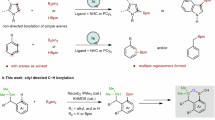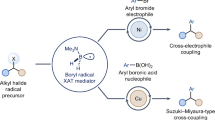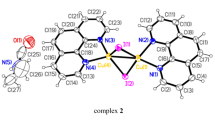Abstract
Abstract
The reaction of benzyl bromides and chlorides with aluminium metal powder or foil (1.2 eqv.) in the presence of catalytic nickel nitrate (10 mol%) in water at room temperature resulted in homocoupling to the corresponding bibenzyl products which were isolated in moderate to good yields. In sharp contrast, the same reaction in organic solvents like dichloromethane, dimethylformamide, acetonitrile, methanol and toluene yielded only a trace amount of the desired product. The scope of the reaction was tested with substituents on the aromatic ring such as Me-, Cl-, CN-, F-, \(\hbox {NO}_{2}\)-, Ph- as well as \(2{^{\circ }}\) benzyl halides.
Graphical abstract
The reagent combination of aluminium metal and catalytic \(\hbox {Ni}(\hbox {NO}_{3})_{2}\) promotes the homocoupling of benzyl bromides and chlorides giving rise to the corresponding bibenzyl products in good to excellent yields. The reaction is greatly facilitated in water and showed good functional group tolerance. Besides the mild reaction condition and bench-friendliness, the present reaction constitutes the first example of aluminium-mediated homocoupling of a halide in water.

Similar content being viewed by others
Explore related subjects
Discover the latest articles, news and stories from top researchers in related subjects.Avoid common mistakes on your manuscript.
1 Introduction
Carbon-carbon bond formation via coupling reactions is one of the most fundamental transformations in organic synthesis.[1] The well-known oxidative addition–transmetallation– reductive elimination sequence is in the textbook premise. On a relative scale, coupling reactions involving organometallic partner bearing sp and \(\hbox {sp}^{2}\) hybridized carbons[2] outwits those having \(\hbox {sp}^{3}\)-hybridized carbon centers.[3] In this regard we were drawn to the \(\hbox {Csp}^{3}\)-\(\hbox {Csp}^{3}\) homocoupling of benzylic halides leading to bibenzyl derivatives, the latter being key building blocks for the synthesis of dyes, polymers, agrochemicals and pharmaceuticals.[4] Although Wurtz coupling is historically the first in alkyl and aryl homocoupling,[5] the post-Wurtz era showed the advent of many reagents for benzylic homocoupling which include either a metal or the dual reagent combination of a metal and a catalytic transition metal partner.[6] Also interesting are the examples of benzylic homocoupling in aqueous medium[7] which are of relevance in the context of green chemistry.
Although aluminium metal has similar electronegativity as zinc, examples of benzylic activation by aluminium metal is lesser explored. The work of Knochel and co-workers on the generation of benzylic aluminum sesquichlorides from corresponding benzyl halide and aluminum powder in the presence of catalytic In(III) halide in THF is worthy of mention here.[8] The benzyl aluminum reagents were transmetallated to the corresponding benzyl zinc reagents and subsequently used for coupling reactions.
In this manuscript, we demonstrate a highly facile homocoupling of benzyl bromide to the corresponding bibenzyl in the presence of aluminum powder (1.2 eqv.) and catalytic Ni(II) salt in water at room temperature. To our knowledge, this is the first example of the use of aluminum metal in C-C coupling in water and adds to its green relevance. Studies on the effect of solvent clearly showed the superiority of water over a host of other organic solvents.
2 Experimental
2.1 General procedure for the homo-coupling of benzyl halides
To a suspension of aluminium powder (1.2 eq) in water (5 mL), \(\hbox {Ni}(\hbox {NO}_{3})_{2}.6\hbox {H}_{2}\hbox {O}\) (10 mol%) was added and the reaction mixture was degassed using argon. The suspension was stirred at room temperature for 5 min. Benzyl halide (3 mmol) was added slowly to the reaction mixture, and the mixture was stirred at room temperature for 48 h under argon. The mixture slowly turned into a clear solution and the bibenzyl crystals were seen to be floating on top of the solution. The mixture was quenched with hydrochloric acid (4M, 5 mL) and extracted with dichloromethane. The combined organic extract was washed with water and dried over \(\hbox {Na}_{2}\hbox {SO}_{4}\). The solvent was removed and the residue was purified by chromatography or recrystallization. All products gave satisfactory spectroscopic data and were compared with authentic sample wherever available.

3 Results and Discussion
In the initial screening, we tested the reaction of benzyl bromide 1a with various metals in water at room temperature under argon atmosphere. In the case of Sn, Zn and Al metals, bibenzyl 2a was obtained in 35, 47 and 58% yields respectively. Next, we explored the reaction of 1a in the presence of aluminium metal (1.2 eqv.) and a catalytic 3d-transition metal salt (Table 1). In the absence of a catalyst, the yield of 2a was 58% (Table 1, entry 1). As catalyst \(\hbox {FeCl}_{3}\) and \(\hbox {CoCl}_{2}\) could not improve the yield (entries 8, 9). On the other hand, water-soluble Ni(II) salts showed significant catalytic effect (entries 2, 4–7). Among various nickel salts, \(\hbox {Ni}(\hbox {NO}_{3})_{2}.6\hbox {H}_{2}\hbox {O}\) was found to be most efficient. After 48 h, the reaction mixture became fully transparent with crystals of 2a floating on top; the latter was isolated in 82% yield (Table 1, entry 6). A similar reaction but with aluminium foil yielded 2a in 65% yield (entry 7).
The water-effect[9] in the present reaction became glaring when we studied the reaction in various organic solvents (Table 2). None of the solvents tried, including polar protic, polar aprotic, as well as non-polar solvents, could facilitate the reaction in a manner that water did. Trace amounts of the product were detected for reactions in methanol, DMF and DCM. As stated earlier, in water, the mixture turned in to a clear solution on completion of the reaction. The clear solution showed a pH value between 6–7 (pH paper).
A recent paper on the reductive coupling of benzyl halides using catalytic Ni(0)-on-alumina in the presence of hydrazine hydrate as co-reductant is noteworthy.[7]\(^\mathrm{b}\) Encouraged by this report we attempted the reaction of 1a (3 mmol) with 80% hydrazine hydrate (2 mL) in water. The colour of the mixture instantly changed from green to pink. Even after 48 h, there was no conversion of 1a, which was isolated back in quantitative yield.

The scope of the present reaction was tested with various substituted benzyl bromide and benzyl chlorides 1a–1n using aluminum powder (1.2 eqv.) and nickel nitrate hexahydrate (10 mol %) as a catalyst in aqueous medium and at room temperature (Table 3). The following results are noteworthy. Benzyl bromides were more reactive than benzyl chlorides, while aryl halides were completely non-reactive (entries 1–3, 7, 10–12, 14, 15–17). Secondary benzyl halides were also amenable to the reaction (entries 8, 9). Both electrons donating (entries 2, 3, 12, 13) and withdrawing (entries 4–7, 14) substituent on the benzene ring were tolerated. The attempted reaction between benzyl bromide and bromobenzene in the presence of Ni(II)/Al did not result in the formation of diphenyl methane as the cross-coupled product.

3.1 \(^{1}\hbox {H}\) NMR monitoring of reaction mixture
The reaction of aluminium metal with benzyl bromide in water being novel, we explored the reaction by \(^{1}\hbox {H}\) NMR in \(\hbox {D}_{2}\hbox {O}\) as solvent (Supplementary Information). A mixture of aluminium powder (96 mg, 3.6 mmol) and benzyl bromide (3 mmol) in \(\hbox {D}_{2}\hbox {O}\) (4 mL) was stirred. After 24 h, the mixture was separated into two parts. In one part, \(\hbox {CDCl}_{3}\) was added and the organic phase was subjected to NMR analysis (Figure S1a, Supplementary Information,). The other part in \(\hbox {D}_{2}\hbox {O}\) was directly checked for NMR using tert-butanol as internal standard (Figure S1b, Supplementary Information,). The organic phase showed the presence of bibenzyl and unreacted benzyl bromide. The aqueous phase indicated the formation of a new product with methylene proton at 1.88 ppm, and phenyl proton at 6.9–7.1 ppm indicating the presence of a benzyl group in the product.[10] Attempts to run ESI-MS of the solution is in progress.
4 Conclusions
In conclusion, we have demonstrated a simple and practical method for homocoupling of benzyl halides using aluminium powder and nickel nitrate as a catalyst under mild conditions in an aqueous medium. Further work in extending the scope of the reaction is in progress.
References
(a) Johansson Seechurn C C C, Kitching M O, Colacot T J and Snieckus V 2012 Palladium catalysed cross-coupling Angew. Chem. Int. Ed. 51 5062; (b) Molander G A and Canturk B 2009 Organotrifluoroborates and monocoordinated palladium complexes as catalysts–A perfect combination for suzuki–miyaura coupling Angew. Chem. Int. Ed. 48 9240; (c) Mesganaw T and Garg N K 2013 Ni and Fe Catalyzed cross-coupling reactions of phenol derivatives Org. Process Res. Dev. 17 29; (d) Li H, Johansson Seechurn C C C and Colacot T J 2012 Development of preformed Pd catalysts for cross-coupling reactions ACS Catal. 2 1147; (e) Wu X-F, Anbarasan P, Neumann H and Beller M 2010 Palladium-catalyzed coupling reactions as key methods in organic synthesis Angew. Chem. Int. Ed. 49 9047; (f) Wang Z-X and Liu N 2012 Nickel catalysed cross-coupling with pincer ligands Eur. J. Inorg. Chem. 901; (g) Grzybowski M, Skonieczny K, Butenschçn H and Gryko D T 2013 Comparison of oxidative aromatic coupling and the scholl reaction Angew. Chem. Int. Ed. 52 9900
(a) Yuan Y and Bian Y 2008 Efficient homocoupling reactions of halide compounds catalyzed by manganese (II) chloride Appl. Organometal. Chem. 22 15; (b) Yamamoto T 2014 Homocoupling of aryl halides promoted by an \(\text{NiCl}_{2}\)/bpy/Mg system in DMF Appl. Organometal. Chem. 28 598; (c) Chen S-Y, Zhang J, Li Y-H, Wen J, Bian S-Q and Yu X-Q 2009 Cobalt-catalyzed homo-coupling of aryl and alkenyl bromide using atmospheric oxygen as oxidant Tetrahedron Lett. 50 6795; (d) Ogawa H, Yang Z-K, Minami H, Kojima K, Saito T, Wang C and Uchiyama M 2017 Revisitation of organoaluminum reagents affords a versatile protocol for C-X (\(\text{ X } = \text{ N }\), O, F) bond-cleavage cross-coupling ACS Catal. 7 3988; (e) Cahiez G, Moyeux A, Buendia J and Duplais C 2007 Manganese- or Iron-catalyzed homocoupling of Grignard reagents using atmospheric oxygen as an oxidant J. Am. Chem. Soc. 129 13788; (f) Biradar D B and Gau H-M 2011 Simple and efficient nickel-catalyzed cross-coupling reaction of alkynylalanes with benzylic and aryl bromides Chem. Commun. 47 10467; (g) Lv L, Qiu Z, Li J, Liu M and Li C-J 2018 N\(_{2}\)H\(_{4}\) as traceless mediator for homo- and crossaryl coupling Nat. Commun. 9 4739
(a) Rudolph A and Lautens M 2009 Secondary alkyl halides in transition-metal catalyzed cross-coupling reactions Angew. Chem. Int. Ed. 48 2656; (b) Jana R, Pathak T P and Sigman M S 2011 Advances in transition metal (Pd,Ni,Fe) catalyzed cross-coupling reactions using alkyl-organometallics as reaction partners Chem. Rev. 111 1417; (c) Frisch A C and Beller M 2005 catalysts for cross-coupling reactions with non-activated alkyl halides Angew. Chem. Int. Ed. 44 674; (d) Huther N, McGrail P T and Parsons A F 2002 Biphasic manganese carbonyl reactions: a new approach to making carbon–carbon bonds Tetrahedron Lett. 43 2535; (e) Barrero A F, Herrador M M, Moral J F Q L D, Arteaga P, Akssira M, Hanbali F E, Arteaga J F, Die’guez H R and Sa’nchez E M 2007 Couplings of benzylic halides mediated by titanocene chloride: synthesis of bibenzyl derivative J. Org. Chem. 72 2251
(a) Cirla A and Mann J 2003 Combretastatins: from natural products to drug discovery Nat. Prod. Rep. 20 558; (b) Baur J A and Sinclair D A 2006 Therapeutic potential of resveratrol: the in vivo evidence Nat. Rev. Drug Discov. 5 493
(a) Wurtz A 1855 Ann. Chim. Phys. 44 275; (b) Wurtz A 1855 Ann. Chem. Pharm. 96 364
(a) \(\text{ VCl }_{2}\text{(Py) }_{4}\): Cooper T A 1973 Reductive coupling of aralkyl halides by vanadium(II) J. Am. Chem. Soc. 95 4158; (b) \(\text{ Co }(\text{ PMe }_{3})_{4}\)/Zn: Fallon B J, Corce V, Amatore M, Aubert C, Chemla F, Ferreira F, Luna A P and Pitit M 2016 A well-defined low-valent cobalt catalyst \(\text{ Co }(\text{ PMe }_{3})_{4}\) with dimethylzinc: a simple catalytic approach for the reductive dimerization of benzyl halides New J. Chem. 40 9912; (c) In: Ranu B C 2000 Eur. J. Org. Chem. 2000 2347; (d) \(\text{ Fe(acac) }_{3}\)/Mg: Xu X, Cheng D and Pei W 2006 Iron catalyzed homocoupling of bromide compounds J. Org. Chem. 71 6637; (e) La: Nishino T, Watanabe T, Okada M, Nishiyama Y and Sonoda N 2002 Reduction of organic halides with lanthanum metal: A novel generation method of alkyl radicals J. Org. Chem. 67 966; (f) \(\text{ NiCl }_{2}\)/Sm: Liu Y, Xiao S, Qi Y and Du F 2017 Reductive homocoupling of organohalides using nickel(II) chloride and samarium metal Chem. Asian J. 12 673; (g) \(\text{ NiCl }_{2}\)(\(\text{ PPh }_{3})_{2}\)/Zn, Mg: Mboyi C D, Gaillard S, Mabaye M D, Pannetier N and Renaud J-L 2013 Straightforward synthesis of substituted dibenzyl derivatives Tetrahedron 69 4875; (h) Ni(\(\text{ PPh }_{3}\))\(\text{(NHC)Br }_{2}\)/Mg: Zhang J, Lu G, Xu J, Sun H and Shen Q 2016 Nickel-Catalyzed reductive cross-coupling of benzyl chlorides with aryl chlorides/fluorides: A one-pot synthesis of diarylmethanes Org. Lett. 18 2860; (j) \(\text{ RhCl }(\text{ PPh }_{3})_{3}\)/Zn: Sato K, Inoue Y, Mori T, Sakaue A, Tarui A, Omote M, Kumadaki I and Ando A 2014 Csp3-Csp3 Homocoupling reaction of benzyl halides catalyzed by rhodium Org. Lett. 16 3756
(a) Fe/Cu: Liu J and Li B 2016 Facile synthesis of bibenzyl by reductive homocoupling of benzyl halides in aqueous media Synth. Commun. 37 3273; (b) \(\text{ Ni/Al }_{2}\text{ O }_{3:}\) Khan S, Ghatak A and Bhar S 2015 Reductive homocoupling of benzylic halides in aqueous medium using recyclable alumina-supported nickel nanoparticles Tetrahedron Lett. 56 2480; (c) \(\text{ Mn/CuI }_{2}\): Ma J and Chan T H 1998 Wurtz-coupling of alkyl halides with manganese/cupric chloride in aqueous media Tetrahedron Lett. 39 2499; (d) Zn/CuI: De S A C P F, Pontes G M A, Anjos J A L D, Santana S R, Bieber L W and Malvestiti I 2003 Reductive coupling reaction of benzyl, allyl and alkyl halides in aqueous medium promoted by zinc J. Braz. Chem. Soc. 14 429
Groll K, Blumke T D, Unsinn A, Haas D and Knochel P 2012 Direct Pd-catalyzed cross-coupling of functionalized organoaluminum Reagents Angew. Chem. Int. Ed. 51 11157
Romney D K, Arnold F H, Lipshutz B H and Li C-J 2018 Chemistry Takes a Bath: Reactions in Aqueous Media J. Org. Chem. 83 7319 and references therein
For benzylaluminium intermediate in organic solvent, the methylene proton appears at 1.66 and 1.81 ppm. Please see: Bulmke T D, Groll K, Karaghiosoff K and Knochel P 2011 New preparation of benzylic aluminium and zinc organometallics by direct insertion of aluminium powder Org. Lett. 13 6440
Acknowledgements
The authors thank the Institute for support including fellowship.
Author information
Authors and Affiliations
Corresponding author
Electronic supplementary material
Below is the link to the electronic supplementary material.
Rights and permissions
About this article
Cite this article
Nayak, M.K., Mukhi, P., Mohanty, A. et al. Ni(II)/Al(0) mediated benzylic \(\hbox {Csp}^{3}\)-\(\hbox {Csp}^{3}\) coupling in aqueous media. J Chem Sci 131, 59 (2019). https://doi.org/10.1007/s12039-019-1638-1
Received:
Revised:
Accepted:
Published:
DOI: https://doi.org/10.1007/s12039-019-1638-1




